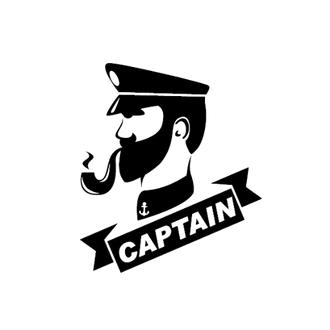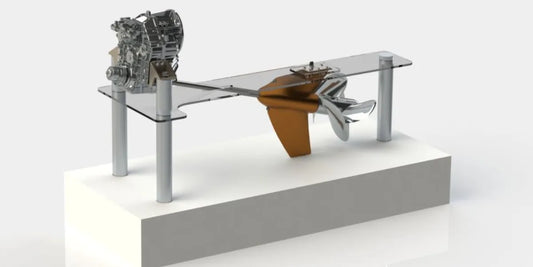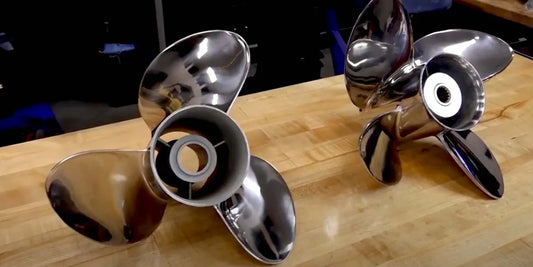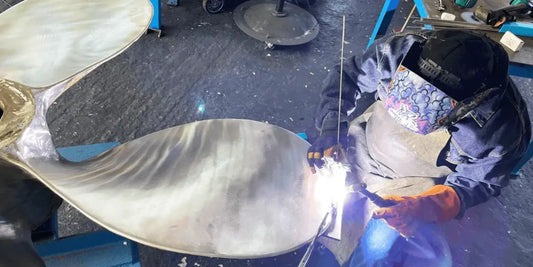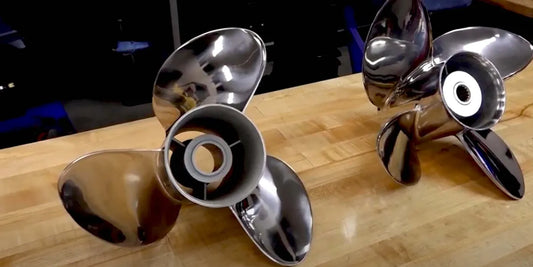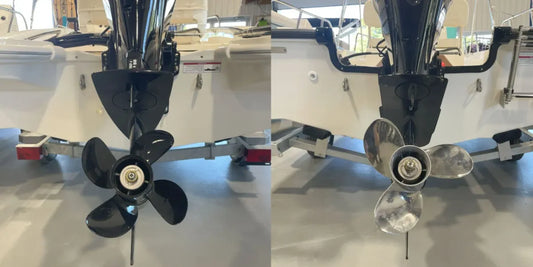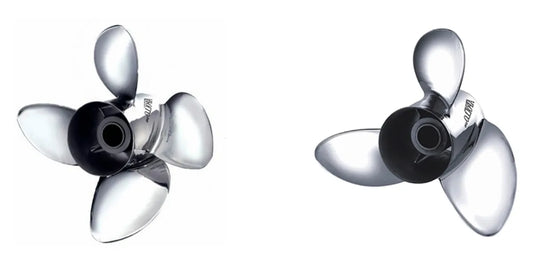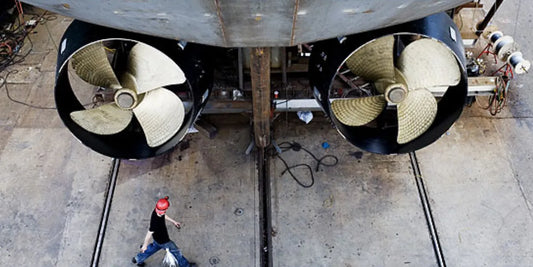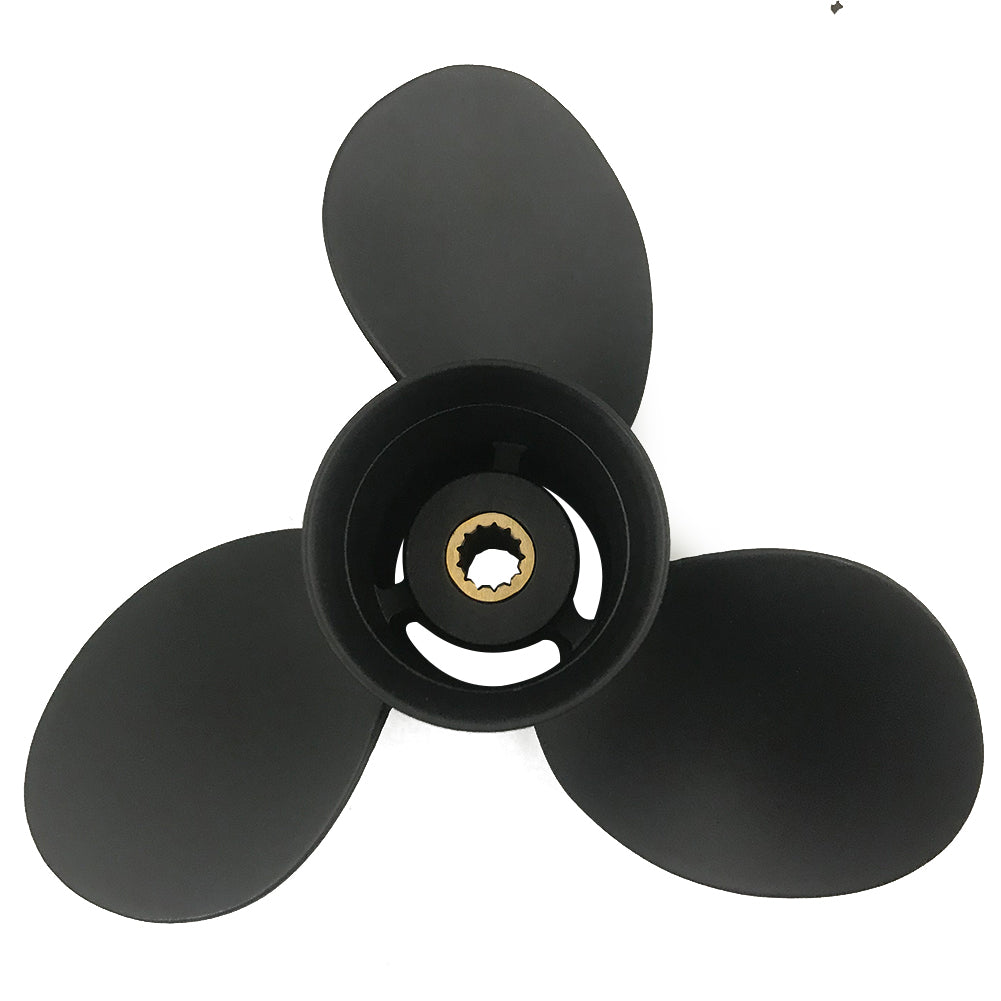Selecting a propeller for a marine vessel is not merely a technical decision; it has synergistic implications for performance, fuel consumption, and hull load, resulting in a smoother ride. For any type of outboard, whether it's an Evinrude or Johnson, a better understanding of propeller selection can optimize vessel handling on the water. This comprehensive guide walks you through key considerations, such as pitch and diameter, as well as those involving material and application, so that you can select a propeller with informed knowledge that matches your needs. By the time you are done with this article, you should be well on your way to increasing your outboard's performance for the best time on the water-every time. So, hit the road! Here is everything you need to get your first Johnson propeller!
Understanding the Johnson Propeller Options

Johnson Outboard Propellers Varieties
When considering Johnson outboard propellers, one must, however, appreciate the various types available to meet different performance requirements and water conditions. We can generally group Johnson propellers into three stages:
Aluminum Propellers: Aluminum propellers are well-known for their versatility and affordability. They perform well in terms of weight and general use. For recreational boating, meant to combine strength with low price, these propellers are adequate. Aluminum props work perfectly in calm waters but may wear out too quickly in rough conditions or during collisions with debris.
Stainless Steel Propeller: Stainless steel propellers are highly sought for their durability and superior performance in high-speed setups or more challenging marine environments. With a rigid construction, they allow perfect power transfer from the engine and prevent any flexing under pressure. Boaters will try stainless steel to help with acceleration, speed, and efficiency. However, they require a significantly higher initial price compared to aluminum.
Performance Propellers: High-performance propellers are planned with precision blade geometry and materials for speed and specific applications, say, watersports or raceboats. Made to suit specific engines or boat types, these props maximize thrust and minimize cavitation. Being able to get the best out of them makes these propellers highly sought after by every enthusiast.
When choosing between the different options, the boater should consider their boat habits, water conditions, and engine specifications as key factors in the selection process. Each type has its unique advantages, with a Johnson outboard propeller able to satisfy every consumer, whether for a casual weekend outing or serious marine work.
Stainless Steel vs. Aluminum Johnson Boat Propeller
Choosing the right propeller material is a crucial step toward achieving peak performance in your boat. Stainless steel and aluminum propellers offer certain advantages tailored to different boating needs and budget constraints.
Aluminum Propellers are immensely preferred due to their inexpensive nature and versatility. They are essentially lightweight and suited for general-purpose boating, where aluminum propellers provide moderate speeds and casual usage. Another advantage of aluminum propellers is their repairability; if they happen to be damaged, such situations may be beneficial for beginners or those who sail in waters that are either shallow or full of debris.
Alternate Propellers have the prestige of durability and performance. Their construction offers strength even at extreme speeds, making them the ideal propellers for high-performance boating or water sports. A stainless steel propeller can maintain accurate blade shapes when subjected to stress, thereby minimizing flexing and yielding an efficient thrust compared to its aluminum counterpart. While the price is higher than that of aluminum ones, they typically last as long as 50 years and are preferred by serious boaters for their improved performance.
In making your choice between the two, consider the horsepower of your engine, the use you will be expecting from the boat, and, of course, your budget. They say aluminum is the best choice for recreational and budget-minded boaters, whereas stainless steel would better serve those who want durability, optimal performance, and long-term value.
Difference between 3-Blade and 4-Blade Propeller
The debate over 3-blade or 4-blade propellers primarily focuses on performance and application. Due to its reduced drag, the 3-blade propeller is designed to increase speed and efficiency, typically achieving the highest top speed. It would be an excellent option for speed-conscious boaters, such as those who engage in water sports or fast cruising. On the other hand, 4-blade propellers provide enhanced thrust with smoother handling. They perform better in heavy loads and rough waters, providing improved acceleration at low RPMs and sustaining consistent speed.
Practically speaking, four-bladed propellers can potentially provide better fuel efficiency at cruise speed and allow faster planing. However, this can sometimes mean a slight decrease in speed compared to 3-bladed propellers. Furthermore, four blades offer greater control, necessary in activities such as trolling or when tight maneuvering is required in marinas and docks.
The ultimate choice ultimately boils down to the purpose for which the boat will be used. A 3-blade prop would be the best choice if speed and efficiency are required. Otherwise, in cases where stability, load carrying, and handling in somewhat difficult conditions are more critical, the 4-blade propeller may be better suited to your needs.
Factors to Consider When Selecting a Johnson Propeller

The propeller size should be matched to the engine.
The propeller size should be matched to the engine for maximum performance and longevity. Propeller size has traditionally been defined by two key dimensions, diameter and pitch. Diameter refers to the total width of the circle traced by the propeller blades. In contrast, pitch refers to the distance the propeller will move forward in one complete revolution in the absence of resistance (theoretical forward distance), much like a screw.
For smaller engines, such as those with a displacement below 50 HP, a propeller with a smaller diameter but higher pitch is considered favorable for achieving the best speed and efficiency. For larger engines, higher-diameter propellers are often required to obtain adequate thrust, especially when hauling heavy loads. Additionally, ensure that your engine operates within its recommended RPMs; this information is typically listed in the engine operating manual section of the handbook. If a propeller's pitch is not correct, it can over-rev your engine, causing strain; or the wrong pitch will under-rev the engine, resulting in poor fuel efficiency and a slow speed.
It's best to consider the type of boat, its weight, and the general usage to ensure that the propeller suits the application. Lower-pitch propellers are best suited for towing or carrying heavy cargo, as they convert thrust into slow acceleration, providing better load handling. For general recreational boats or speedboats, pitch-wise, the higher pitch should be selected, as it will ensure the boat attains higher top speeds while not requiring the engine to work harder on extended runs. Always follow your engine manufacturer's performance recommendations to achieve the right balance.
Performance Considerations for Outboard Motors
Fuel efficiency is a significant criterion for measuring the performance of outboard motors. Selecting the correct motor size for the vessel can significantly impact the amount of fuel a boat consumes during its operational period. An overpowered boat using an oversized motor would consume fuel unnecessarily; an underpowered one would force the engine to operate inefficiently, reducing its lifespan. Another reason is that modern outboard motors are equipped with fuel injection and electronic controls that optimize fuel consumption, ensuring a fair balance between performance and economy.
Next comes the second potentially critical factor: the weight of the motor about its power. A suitably sized engine will provide the boat, under most circumstances, with swift planing, good handling characteristics in diverse water conditions, and rated stability in different loads. Of course, maintenance is the crucial consideration. Routine checks on the propeller, fuel systems, or simply cleaning debris out of the cooling system can avert huge performance problems. Nowadays, many manufacturers include digital monitoring systems that record real-time engine parameters, such as RPM, fuel consumption, and temperature, so that boaters can warn themselves early of potential inefficiencies or outright failure.
Weight and Materials, affecting the Performance of a Boat
The more weight and material composition are added to a boat, the greater becomes the importance of speed, fuel consumption, and efficient handling. A heavier boat will presumably always be lower in the water, resulting in more resistance or drag and, therefore, less speed. Hence, they favor lightweight materials such as aluminum or even more advanced composite materials like carbon fiber, which provide an increased strength-to-weight ratio, permitting boats to achieve higher speeds and better fuel economy than those that are stiff.
Maintenance requirements and longevity are dependent on the material. For example, fiberglass is the preferred material for resisting corrosion and is suitable for saltwater environments, whereas aluminum, strong and less likely to crack, would be the best choice. Industry studies have pointed out that the changeover from steel hulls of the conventional variety to composite materials can result in the reduction of vessel weight by as much as 30%, contributing to an increase in fuel efficiency of 15-20%. Yet, cost, purpose, and environmental considerations also need to be taken into account in material selection.
Weight distribution must be correctly optimized. Improper weight distribution causes a range of troublesome effects when trying to balance or achieve proper trim, thereby making a vessel inefficient and unsafe. Contemporary boat designs incorporate engineering principles and computational fluid dynamics (CFD) simulations to ensure proper weight distribution and optimal hull performance. This, in a way, illustrates the profound interconnection between material science, design, and boat efficiency.
Upgrading Your Johnson Outboard Propeller

When to Replace Your Current Propeller
Knowing when a Johnson outboard propeller requires replacement is essential for good performance and fuel economy. Worn-out propellers can reduce speed, increase fuel consumption, or even become a source of stress on the engine. Some indicators that may suggest replacement include visual damage to the propeller or bending of the blade edges. Such deformities impair water flow and consequently thrust. Any further suffering in machining speed, accompanied by an unusually slow rise in RPM without achieving a good plane, might be a sign of propeller issues. Eventually, these materials might degrade due to corrosion caused by saltwater life and gradual wear and tear.
By embracing a propeller setup that substitutes for the coordinates of your boat, the vessel will steer more accurately, and vibrations will be reduced while achieving significantly better speeds and efficiencies. When considering replacement, take into account the blade design, pitch, and material. For instance, stainless steel propellers are heavier and more durable, making them suitable for applications requiring heavy usage and high performance; meanwhile, aluminum is cheaper and offers weight advantages. Having your propellers inspected from time to time, with replacements made when necessary, just makes your work more pleasurable and easier.
How To Choose OEM Versus Aftermarket Options
The various advantages and disadvantages need to be weighed when selecting the best solution for your needs. The OEM propellers are manufactured by the original manufacturer of your boat or engine, ensuring precision compatibility and optimal performance. Quality materials and engineering guarantee these units to a high degree, possibly eliminating any chance of performance mismatches. However, all these benefits undeniably come with a higher price.
Aftermarket propellers, on the other hand, provide a wide array of choices at different price levels. This can often be a more cost-effective alternative without compromising performance. Many reputable aftermarket brands invest considerable resources in research and development to create innovative designs that offer features such as improved fuel efficiency or cavitation resistance. That said, the quality of aftermarket props can vary widely; therefore, it is crucial to select those made by trusted manufacturers with a good reputation and proven performance.
For example, if you require longevity and high performance in harsh working conditions, consider an OEM stainless steel propeller as your best option. And suppose you have multiple setups to check or are still working on a tight budget. In that case, it's certainly a good idea to see if you can get an aluminum aftermarket prop with good performance without blowing your precious budget.
Ultimately, this decision should complement your usage style, orientations, and long-term budgeting. Always refer to the manufacturer's specifications for your boat and seek professional advice to maintain optimal performance and safety. Regular performance checks and other maintenance procedures will further enhance the propeller's value, regardless of the type of propeller you've chosen.
Benefits of Performance Propeller Upgrade
Upgrading to performance propellers can offer significant advantages to both the recreational and professional aspects of your life. One of the key advantages is fuel efficiency; unlike standard propellers, the performance propeller reduces drag and optimizes propulsion, resulting in less need to stop for fuel and lower operating costs. They also help deliver a bit more speed and acceleration; therefore, in rougher water conditions, you should feel smoother handling and better responsiveness.
From cavitation to vibrations, performance propellers contribute to enhanced comfort and durability. An extra thrust with good power distribution does make the performance-related problems of fishing, water sports, or carrying heavy loads more noticeable. Certain contemporary performance propellers are made with new materials and designs that facilitate corrosion resistance, durability, and less downstream replacement and maintenance. Investing in a performance propeller is a step forward from just the product to the execution of an improved boating experience, enhanced by efficiency and reliability.
Installation and Maintenance of Johnson Outboard Propellers

Step-By-Step Installation Procedure
Preparation Tools and Materials: Before installing, ensure you have all tools, including a wrench, pliers, grease, and a propeller kit. Check the new propeller to ensure it fits the specific Johnson outboard in the same way as specified in the manufacturer's manual.
Safety Precautions: Turn off the outboard motor and disconnect the battery to prevent any untoward incidents during installation. Dock or secure the boat on a trailer for stability.
Removing the Beaver Dam Propeller: The propeller nut is located at the center of the existing propeller; use a wrench to loosen the nut. Slowly, but surely, slide off the old propeller from the shaft, making sure it stays intact. Inspect the shaft and key for any signs of road rash or wear.
Inspect and Clean the Shaft: With the entire propeller shaft clean, any debris, old grease, or corrosion is removed. Apply a very light coating of marine grease to the shaft for ease of sliding and to protect it from corrosion due to aging.
Install the New Propeller: Align the new propeller with the shaft, ensuring that the hub aligns with the splines correctly. Then fit the washer and secure the propeller using the nut supplied with the kit. Use a wrench to tighten the nut to the manufacturer's specified torque, ensuring it is not overtightened or damaged.
Check and Adjust: Using your hand, turn the propeller to ensure it moves freely with no impediments and maintains balance. Also, check that all components, such as spacers or locking mechanisms, are correctly aligned according to the installation instructions.
Secure and Test: After a propeller is newly installed, reconnect the battery and run the motor at low speeds to confirm the propeller is in good working condition. Watch for smooth operation, vibrations, or noise from the propeller.
Monitor and assess performance: Monitor the propeller's performance during its initial outings to gauge its level of efficiency. Consult the user manual and your marine technician for adjustments if any situations arise.
By following these detailed steps, you ensure optimum performance of your Johnson outboard propeller and, thereafter, ensure your boating experience is one of the best.
The Regular Maintenance Tips for Prolonged Life
Proper maintenance for your Johnson outboard propeller is a vital key to ensuring reliability and utmost performance over time. Below are some tips worth considering if you want your Johnson propeller to last long and withstand the test of time.
Inspect for Damage Regularly: Check the propeller for dents, cracks, or other visible damage. Even minor imperfections can reduce efficiency or lead to more significant problems if left untreated. Quick visual inspections after each outing aid greatly in catching problems while they are still small.
Debris Cleaning: Clean away weeds, fishing lines, or any other debris that could cause fouling and wrap around the propeller hub immediately after each use. Such buildup, if allowed, will quickly prove to stress the motor and reduce performance.
Check for corrosion, especially in saltwater environments. After each saltwater venture, rinsing the propeller with fresh water will prevent salt and corrosive elements from accumulating.
Lubricate Moving Parts: Ensure the propeller shaft and any connecting parts are properly greased to prevent seizure and reduce friction. Use marine-grade grease for the best results.
Balance and Alignment: Keep the propeller free from unwanted alignments and imbalances, such as vibrations that can shorten the lifespan of the propeller and engine components.
Monitor Prop Nut and Cotter Pin: Continuously check the prop nut and cotter pin to confirm they are in place. Tighten them upon necessity, but never over-torque, as that causes damage.
Store Properly During the Off-Season: If it will not be in use for an extended period, remove the propeller from the setup, give it a thorough wash, and coat it with corrosion-preventative. Afterward, wrap the propeller with suitable materials and place it in a dry, safe location.
Schedule Professional Servicing: Occasionally, have your propeller and outboard motor inspected by a certified marine technician. Such an inspection might reveal problems that you have overlooked, and would aid in the efficient operation of the entire system.
The maintenance routines equip you with a longer lifespan for your propeller, promote fuel efficiency, lessen the engine's wear and tear, and allow for smooth boating experiences. Investing in preventive maintenance means avoiding significant repair expenses and enjoying a more enjoyable sailing experience over time.
Common Issues and Troubleshooting
It is a general set of problems relating to propeller maintenance and performance that can be prevented by proper maintenance and observation. Some common issues and their solutions are provided here, allowing you to troubleshoot properly and maintain optimal functionality.
Propeller Damage: Cracks, chips, or bent blades cause imbalance and impede thrust and therefore constitute a serious problem for performance. Always conduct a visual inspection of the propeller before and after each outing. Minor damages can be repaired, while significant damages require replacement to restore efficiency and prevent engine strain.
Cavitation: Air bubbles are created around the blades of the propeller, resulting in poor thrust and potential long-term damage. Factors leading to this may be an incorrect blade pitch, a damaged propeller surface, or marine growth upon the blades. Measures against this problem include cleaning the propeller, checking the blade pitch, and ensuring the propeller is fitted correctly.
Overheating: The engine may overheat when the propeller is not selected and matched to the boat. Typically, this occurs when the propeller overpowers the engine or there is insufficient water circulation for cooling. Check the temperature gauge of your engine and ensure that the propeller, considering its size and pitch, complies with the manufacturer's recommendations.
Low Acceleration or Speed: The boat may be struggling to reach its top speed or acceleration due to the presence of debris fouling the propeller, an incorrect propeller size, or wear. Cleaning at regular intervals, selecting the correct specifications for the propeller, and replacing worn-out items can resolve this issue.
Problems with Vibration: Normally, excessive vibration will be a symptom of imbalance from a damaged or improperly seated propeller. Check the mounting hardware and ensure that the propeller shaft is aligned straight. Ensure that any loose bolts are tightened and that any damaged parts are replaced.
Fuel Inefficiency: A damaged or improperly-sized propeller causes the engine to consume excessive fuel. Fuel efficiency can be optimized by keeping the propeller clean and inspecting it regularly, ensuring it meets the performance requirements of your boat correctly.
Staying proactive about inspections, even when addressing early problems, can significantly enhance your boating experience and reduce the need for costly repairs or downtime.
Choosing the Right Propeller for Different Marine Applications

Propeller Recipe for Fishing Boats
While discussing the best types of propellers for a fishing boat, I focus on the elements of durability, performance, and fuel efficiency. For all kinds of fishing activities, I typically use a stainless steel propeller. It is a good choice to withstand contact with debris or shallow waters, which are common occurrences when cruising fishing areas. Its heightened performance compared to aluminum increases acceleration and top speed, which is helpful while rushing to faraway fishing spots or on a speedy return trip to shore.
Another crucial consideration is pitch and blade design. Lower-pitch propellers suit fishing boats more, as they deliver the thrust and control needed at lower speeds—that is precisely what I require when trolling or maneuvering into tighter spots. The three- or four-blade prop should likewise offer one greater degree of handling and stability in choppy or unpredictable waters. I also consider horsepower matched to my engine and boat loads as a factor for the optimal combination for maximum efficiency and performance.
Finally, I consider the actual fishing terrain. If the fishing is predominantly in saltwater, I opt for a corrosion-resistant prop. Freshwater fishing requires my propeller to be durable and efficient. Proper prop selection will enhance the boat's overall performance and ensure a smooth, pleasant fishing experience every time I am out there.
Universal Propellers for Recreational Boating
When buying a propeller for recreational boating, I would consider one that strikes a balance between performance, efficiency, and a certain level of durability. Aluminum propellers are often my choice due to their lightness and low price when I decide to use them for casual outings. Smaller boats, such as those needing somewhat reasonable speeds to cruise and day boat, would be the prime candidates. Should I plan on engaging in high-speed activities or towing activities like waterskiing and tubing, I lean towards steel ones. Steel's strength and thin blades help to maximize speed and acceleration, thereby improving the overall boating experience.
The pitch and diameter of a propeller are other factors I consider, as both of these parameters significantly affect the performance of boats. Low-pitch propellers have good acceleration, making them perfect for water sports. Conversely, a higher-pitch propeller will have better top-end speed, which is desirable for long-distance cruising. Then, I ensure that I match the propeller type with my boat engine's specification and typical use to achieve optimal fuel economy and minimum engine strain.
The final considerations are water conditions and my typical boating environment. If I am forced to wash in rough or shallow waters, a composite propeller, which is forgiving and can sustain minor impacts, would be a suitable choice. For smoother, open waters, the known metals usually suffice. By taking these considerations into account, I can confidently select the propeller that best enhances my boating experience and keeps the boat performing optimally.
Special Considerations for High-Performance Outboards
Anything related to prop selection is exact and tailor-made for high-performance outboards. To achieve the boat's maximum speed and efficiency, I look for a highly engineered propeller, such as one made of stainless steel with a higher blade count or progressive pitch. This design helps provide uniform thrust on the blades and limits slippage, which is detrimental when encountering higher speeds or more adverse conditions. From the diameter to the pitch, I ensure that every parameter aligns with my engine's horsepower and intended performance style, whether that be an emphasis on faster acceleration or greater top speed.
I also consider the particular requirements stemming from my boating activities. On racing occasions or in some competitive scenarios, I might want to opt for a prop with a lightweight, high rake to maximize the aerodynamic lift and stability of the hull at top speeds. For quicker planning for waterskiing or wakeboarding, a low-pitch propeller could make a faster hole shot. The more I understand the trade-off between speed, handling, and fuel economy, the better I can make a choice that suits my exact needs and overall goal on the water.
Ultimately, I understand the importance of testing and fine-tuning. The great rigs need work, and through trial and error, I arrive at a propeller style, size, and configuration that fits my exact outboard engine. When I pedal into the manufacturers or propeller experts and bring data to the table, such as RPM readings, I can truly optimize my outboard performance. All of that attention ensures that my propulsion system runs smoothly and efficiently, aligning with how I like to boat and my expectations.
Reference Sources
-
Choosing the Correct Boat Propeller - Crowley Marine
A detailed guide on selecting the right propeller, including tips on pitch and engine RPM. -
Evinrude / Johnson Prop Finder - PropMD
A tool to find compatible Johnson propellers based on engine horsepower and year. -
Choosing the Right Propeller for Your Boat or Pontoon - YouTube
A video guide explaining how to select the right propeller for optimal performance. -
Evinrude Propeller Selection Guide - BRP
A comprehensive propeller selection guide for Evinrude and Johnson outboard motors. -
Johnson Outboard Boat Propeller - Propeller Depot
A resource to narrow down Johnson propeller options based on specific engine requirements.
Frequently Asked Questions (FAQs)
Are there any benefits to using a Johnson outboard propeller?
The Johnson outboard propeller is renowned for its high performance and durability. Aluminum, stainless steel, and similar materials are used for this prop, producing significant thrust and efficiency for outboard motors within the range of 40-140 hp. This prop is capable of excellent handling and speed. It has a considerable following among boat lovers. Also, Johnson propellers are designed to fit essentially any gearcase, so you can find one to match your engine. Replacement props are also commonly available, making servicing an easy task.
How should I go about finding a suitable Johnson propeller for my boat?
Several factors contribute to selecting the right Johnson propeller, including the type of boat and the engine specifications. You would need to locate a propeller that fits your outboard motor and meets the horsepower requirements, typically in the range of 40-140 hp. You would consider whether you wanted a 3- or 4-blade configuration, which affects performance. Match the spline count as well; many Johnson props are available with a 13-spline or 15-spline. Consulting with a marine expert would be beneficial to you.
What materials are Johnson outboard propellers made from?
Johnson outboard props are typically made from high-quality aluminum and stainless steel. Aluminum props are lightweight and perform well in casual boating environments; the stainless steel variety offers more durability and efficiency in rough waters. The choice between these two may depend on your style and budget. Stainless steel props are usually more expensive, but generally, they're regarded as a better long-term investment because they don't wear down or corrode.
Can I change the prop on my existing Johnson?
Yes, upgrading the existing Johnson prop is a common scenario among boat owners seeking a performance upgrade. Depending upon your requirement for increased speed, fuel economy, or better handling, different options may be available. You may go for a change in pitch or style, from 3-blade to 4-blade, to name one. Michigan Wheel and Solas, among other brands, manufacture props compatible with Johnson outboards. Consult a prop guide or, once in a while, a marine specialist to give guidance on the best upgrade actually to meet your needs.
Where is a place for Johnson propellers to be found?
In replacement situations, Johnson propellers are mainly retailed at marine supply establishments. Some operators do specialize in marine products and services, making it much easier to identify and obtain the exact model needed. Websites will allow you to view detailed specifications, including spline counts and material type information, necessary to verify proper outboard fitment. You may also want to contact local dealers for the best advice on product selection, including OEM options and aftermarket alternatives, such as those offered by OJ Props.
What's the price range for Johnson propellers?
Johnson propeller prices can vary extensively depending on the material, shape, and brand. Basic aluminum types are generally more affordable, but high-performance stainless steel types are significantly more expensive. Typically, you can find Johnson propellers anywhere from $100 to $600. Therefore, you must weigh the quality and price to get a product that meets your performance needs without burning a hole in your pocket. Always check with different retailers to find the best price for Johnson propellers.
